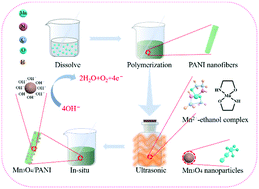Highly efficient OER catalyst enabled by in situ generated manganese spinel on polyaniline with strong coordination†
Abstract
The oxygen evolution reaction (OER), as the rate-determining step of electrochemical water splitting, is extremely crucial, and thus it is a requisite to engineer feasible and effective electrocatalysts to shrink the reaction energy barrier and accelerate the reaction. Herein, monodisperse Mn3O4 nanoparticles on a PANI substrate were synthesized by polymerization and in situ oxidation. Combining Mn3O4 nanoparticles and PANI fibers can not only maximize the strong coupling effect and synergistic effect but also construct a well-defined three-dimensional structure with extensive exposed active sites, where the permeation and adherence of the electrolyte are made exceedingly feasible, thus displaying excellent OER activity. Benefiting from the outstanding structural stability, the resulting Mn3O4/PANI/NF is able to deliver a low overpotential of 262 mV at a current density of 10 mA cm−2, which outperforms the commercial RuO2 catalyst (275 mV) as well as presently reported representative Mn-based and PANI-based electrocatalysts and state-of-the-art OER electrocatalysts. The synthetic method for Mn3O4/PANI not only provides a brand-new avenue for the rational design of inorganic material/conductive polymer composites but also broadens the understanding of the mechanism of Mn-based catalysts for highly enhanced OER.



 Please wait while we load your content...
Please wait while we load your content...